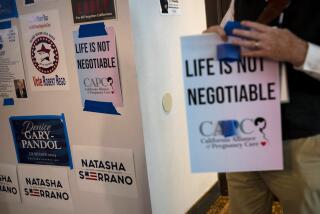Forced Sterilization: a Stain on California
It’s time for California to make amends for one of the most horrific and shameful episodes in the state’s history. Between 1909 and 1964, more than 20,000 people in California were robbed of their reproductive abilities through a state program of forced sterilization. Under the misleading guise of “race betterment,” doctors at California’s state hospitals sterilized those who were considered “unfit to propagate.”
The origins of California’s forced-sterilization program lie in the misnamed eugenics movement of the early 20th century. The term means “good breeding” and stemmed from efforts to improve plant and livestock breeds. But those who believed that “degenerates” and the “feeble-minded” should be prevented from having child- ren launched campaigns for state laws to permit the sterilization of people with such deficiencies.
In 1907, Indiana became the first state to pass a forced-sterilization law, and California followed suit in 1909. Thirty states ultimately enacted such laws, and some 64,000 people -- most of them poor, young women -- were subjected to the surgeon’s knife without their consent.
Performing any operation without the patient’s consent raises serious legal questions. The U.S. Supreme Court, however, upheld forced sterilization in the 1927 case of Buck vs. Bell, which challenged Virginia’s “race betterment” law.
Justice Oliver Wendell Holmes, noted for his free-speech decisions, wrote a callous opinion that approved the sterilization of Carrie Buck, a 17-year-old girl who was labeled as feeble-minded.
Carrie Buck was not mentally retarded or abnormal in any way but was sterilized because she had a child out of wedlock and was considered “morally delinquent.”
Holmes wrote that “instead of waiting to execute degenerate offspring for crime, or to let them starve for their imbecility, society can prevent those who are manifestly unfit from continuing their kind.”
Encouraged by this ruling, sterilization advocates took their campaign abroad. The leading American eugenicist, Harry Laughlin, who never met Buck but testified at her court hearing that she was a “low-grade moron,” helped to draft the Nazi regime’s “race hygiene” law, under which some 2 million Germans were sterilized.
In California, most involuntary sterilizations were performed on patients in state mental hospitals. More than half were diagnosed as manic- depressive or schizophrenic. But many were simply “burdens” on state institutions.
In 1921, the director of the Agnew State Hospital urged the sterilization of a female patient because she was “depressed” and “further pregnancies would be a hindrance for her remaining stable.”
The state director of hospitals in the early 1920s, Dr. Frederick Hatch, sent dozens of “eugenics field workers” into poor neighborhoods, looking for sterilization candidates. One historian wrote of this program: “Individuals were labeled ‘degenerate’ or ‘feeble-minded’ based on dirty clothing or an unkempt appearance. Children were labeled ‘imbecile’ based on a glance from across the room.”
California’s longtime attorney general, U.S. Webb, urged sterilization for “inebriates, prostitutes, tramps and habitual paupers found in our county poor-asylums.”
The eugenics movement gradually lost influence, through scientific debunking of claims that “moral delinquency” was inherited and through revulsion at its Nazi connections. But the last forced-sterilization law was not repealed until 1979. In recent years, advocates for the mentally and physically disabled have begun redress campaigns for the victims of these laws.
During the last year, four governors have responded with apologies on their states’ behalf. Last May, Virginia’s governor, Mark Warner, expressed his “sincere apology” to the 8,000 victims of his state’s law and said “the eugenics movement was a shameful effort in which state government never should have been involved.” In December, then-Gov. John Kitzhaber of Oregon acknowledged the “great wrong” done in the name of eugenics to 2,600 “vulnerable, helpless citizens” of his state. The same month, Gov. Mike Easley of North Carolina said, “I deeply apologize to the victims and their families for this past injustice, and for the pain and suffering they had to endure over the years.” Then-Gov. Jim Hodges of South Carolina issued the most recent state apology, on Jan. 8.
California sterilized more of its residents than these four states combined -- close to a third of the national total, in fact.
There is recent precedent in California for a state apology to victims of official discrimination: the Japanese Americans who were dismissed from state employment during World War II. The first President Bush also issued a “sincere apology” in 1990 to Japanese Americans for their internment during that war.
It’s only fitting that Gov. Gray Davis acknowledge the serious injustices of California’s forced-sterilization program by apologizing to its surviving victims. Their numbers may be small, but their suffering was great.
More to Read
Get the L.A. Times Politics newsletter
Deeply reported insights into legislation, politics and policy from Sacramento, Washington and beyond. In your inbox three times per week.
You may occasionally receive promotional content from the Los Angeles Times.










